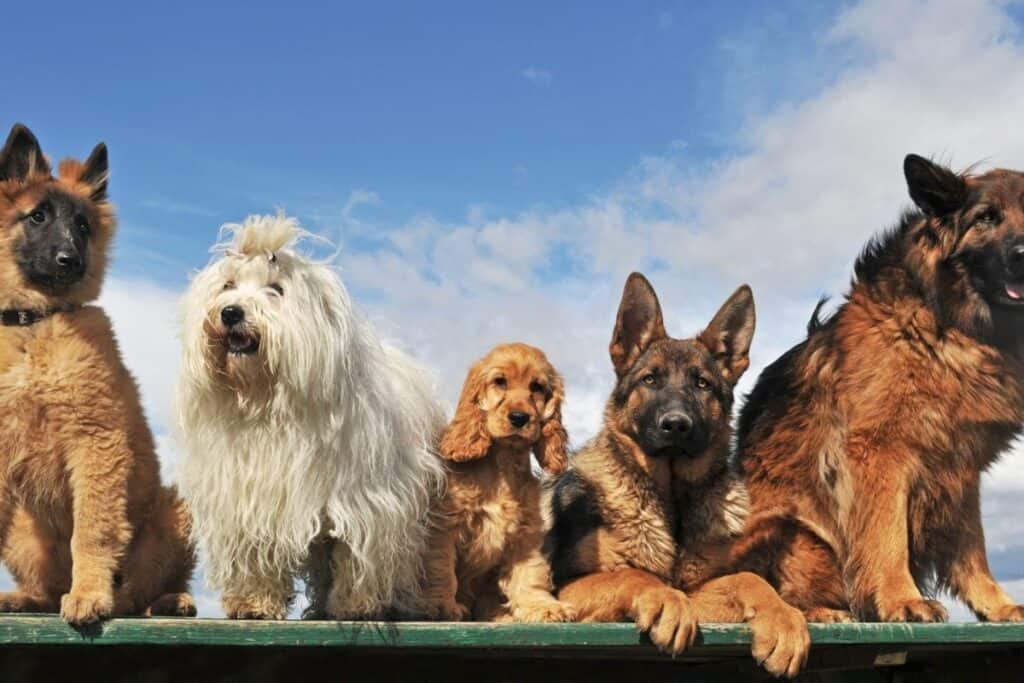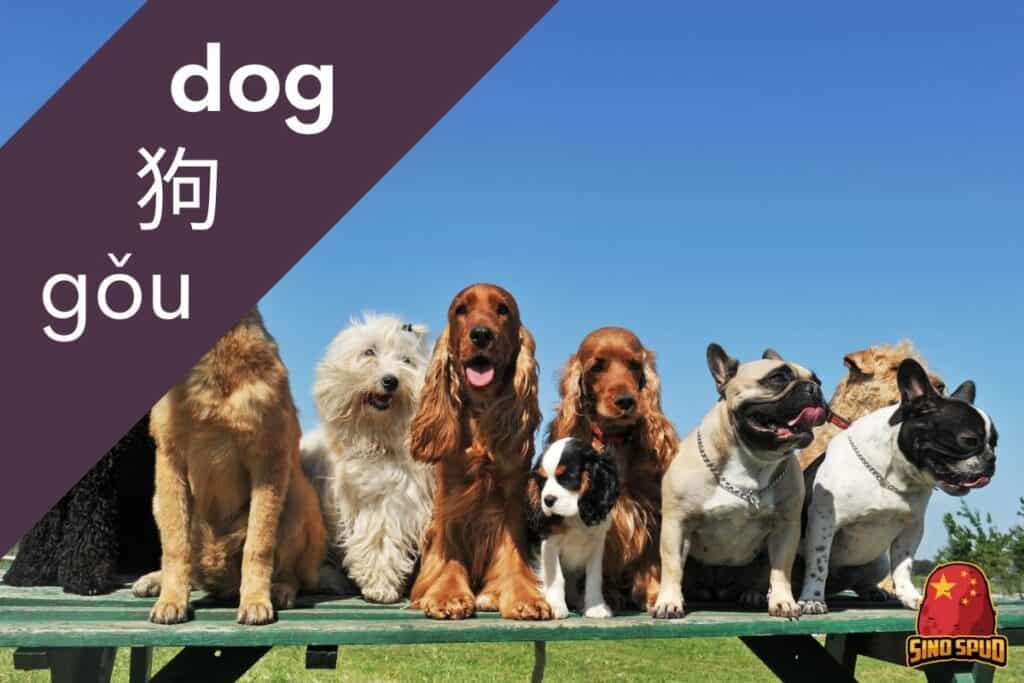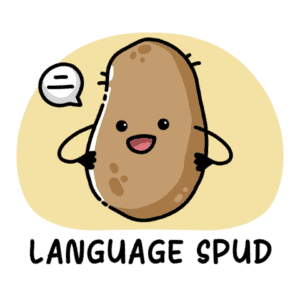
Other than cats, small birds, voles, mice, and some insects… Who doesn’t love dogs?
Our furry friends have long been known to be man’s best friends, and today they’ll even help us learn Mandarin Chinese.
In this post we’ll go over the name of various dog breeds in Chinese, including dog breeds from China itself as well as the more internationally renowned breeds.
We’ll also be offering some more general terminology and interesting trivia here and there.
As usual, you will be able to learn both the Chinese Characters that make each name and their accompanying pinyin at the same time. This way you’ll be able to grasp both the unique characters and practice your pronunciation.
So, let’s start off by going over Chinese breeds of dogs.
Chinese Dogs
Believe it or not, few cultures have such a dedicated history with dogs as China. For over 7000 years the
Chinese people and their furry friends have worked together, hunted together, and even been royalty
together… And yes, it’s true, Chinese dogs have also been eaten from time to time.
Chinese dog breeds range from dedicated guardians to herders and even dedicated royal
companions. As such China’s dog breeds are known for their variety, and you’ll find some of the most
endearing breeds in the world in China.
Pug | 巴哥 | bāgē
Pugs are believed to have originated as early as 400 B.C. in China. So not only are Pugs adorable, they are also some of the oldest dogs in the world!
Pekingese | 京巴狗 | jīng bā gǒu
According to local folklore, the Pekingese is believed to be a Lion shrunk down by Buddha himself! Now, that may or may not be true (it isn’t), but the long history of the Pekingese as companion pets to the royalty isn’t any less fancy.
Shih Tzu | 西施犬 | xīshīquǎn
The Shih Tzu is another breed famous for its similarity to lions, its name is even derived from Lion!
Shar-Pei | 沙皮狗 | shāpígǒu
Also known as ‘Bone Mouth’, over 2000 years ago, Shar-Peis were dedicated hunting dogs. However, modern Shar-Pei mostly come from American breeders.
Chow Chow | 松狮犬 | sōngshīquǎn
Believe it or not, these fluffy pals were also guarding dogs back in their heyday. They’re not exactly the scariest-looking dogs on this list!
Chinese Crested | 中国冠毛犬 | zhōngguó guān máo quǎn
Nobody is quite sure where the Chinese Crested dog comes from, but it’s unlikely it came from China. The most common theory is that hairless dogs from Africa arrived in China and were bred with local dogs.
Xiasi Dog | 下司犬 | xiàsīquǎn
This breed of dog is native to Guizhou province. There’s a deep-rooted belief in Guizhou that Xiasis can bring wealth to your family.
Kunming Wolfdog | 昆明狼 | kūnmíng láng
Also known as the Chinese German Shepherd, the Kunming Wolfdog is one of the youngest Chinese breeds on this list. They only started appearing in the 50s, so they aren’t even a hundred years old. If you see a police dog in China, it’ll most likely be a Kunming Wolfdog.
Japanese Chin | 日本下巴 | rìběn xiàbā
While the Chin might have become popular in Japan, most experts believe the breed is in fact Chinese. Legend has it that Chinese Emporers gifted a few to Japanese royalty back in the day which is why they’re commonly seen in both nations.
Formosan Mountain Dog | 高砂 | gāoshā
Can you believe this dog breed is over 20,000 years old? That’s pretty ancient. Originally from Taiwan.
Chongqing | 重庆犬 | chóngqìng quǎn
The Chongqing has become a rare dog with time, but it has been present in China for well over 2,000 years. As you might have guessed, this dog comes from the city of Chongqing.
Lhasa Apso | 拉萨阿普索 | lāsà ā pǔ suǒ
One of many dog breeds originating in Tibet. In a similar fashion to the Chow Chow, these seemingly cute dogs were previously bred as guard dogs.
Dog Breeds in Chinese

Now that we’ve looked at some popular breeds that originate from China, it’s time to turn the dog vocabulary up to 11.
There’s no shortage of dogs all over the world, and you are bound to impress your Tinder date if you know the Chinese pronunciation for breeds like Golden Retriever or Poodle.
This is also a great opportunity to understand the small nuances of translations. In the above category, a lot of names were very similar or almost interchangeable in English and Chinese. However, now that we’ll be getting deep into the most traditional dog breeds you’ll come across some unexpected names for dogs.
| Dog Breed | Chinese | Pinyin |
| Akita | 秋田犬 | qiūtiánquǎn |
| Beagle | 比格犬 | bǐ gé quǎn |
| Bloodhound | 猎犬 | lièquǎn |
| Boxer | 拳师 | quán shī |
| Bulldog | 牛头 | niú tóu |
| Chihuahua | 吉娃娃 | jíwáwá |
| Cocker Spaniel | 可卡 | kě kǎ |
| Collie | 牧羊犬 | mùyáng quǎn |
| Dachshund | 短腿猎 | duǎn tuǐ liè |
| Dalmation | 斑点 | bān diǎn |
| Doberman | 杜宾 | dù bīn |
| German Shepherd | 德国牧羊犬 | déguó mùyáng quǎn |
| Golden Retriever | 金毛犬 | jīnmáo quǎn |
| Great Dane | 大丹犬 | dà dān quǎn |
| Husky | 哈斯基 | hā sī jī |
| Labrador | 拉布拉多 | lā bù lā duō |
| Poodle | 贵宾 | guì bīn |
| Newfoundland | 纽芬兰 | niǔfēnlán |
| Mastiff | 獒犬 | ào quǎn |
| Rottweiler | 罗特伟尔 | luótèwéiěr |
| Saint Bernard | 圣百纳 | shèng bǎi nà |
| Sheepdog | 牧羊 | mù yáng |
| Spitz | 斯皮茨 | sī pí cí |
| Yorkshire Terrier | 约克夏犬 | yuēkè xià quǎn |
| Welsh Corgi | 威尔士柯基犬 | wēi’ěrshì kē jī quǎn |
| Schnauzer | 雪纳瑞 | xuě nà ruì |
| Shiba Inu | 柴犬 | cháiquǎn |
| Samoyed | 萨摩耶 | sàmó yé |
| Sheltie | 谢尔蒂 | xiè ěr dì |
Caring for your Dog
By now you’ve got the dog breeds down. If not, make sure to add the names above to your flashcard deck.
However, we’re not done yet!
What about language related to taking care of your pup?
| Animal Care | Characters | Pinyin |
| bone (for dog) | 狗骨头 | gǒu gǔtou |
| food bowl | 饭盆 | fàn pén |
| kennel | 狗窝 | gǒu wō |
| to breed (animals) | 饲养 | sì yǎng |
| to tame | 驯化 | xùn huà |
| to train (animals) | 训练 | xùn liàn |
| to feed | 喂养 | wèi yǎng |
| pet store | 宠物店 | chǒng wù diàn |
| muzzle (for dog) | 嘴套 | zuǐ tào |
| (animal) collar | 颈圈 | jǐng quān |
| breed (of the dog) | 绰号 | chuò hào |
| pedigree | 血统 | xuè tǒng |
| play | 玩 | wán |
Other Dog Vocabulary
| bark | 吠 | fèi |
| bite | 咬人 | yǎo rén |
| gnaw (bone) | 啃 | kěn |
| hair (animal) | 毛 | máo |
| mouth (animal) | 嘴 | zuǐ |
| paw | 爪 | zhuǎ |
| scratch | 抓破 | zhuā pò |
| sniff | 闻 | wén |
| snout | 口鼻部 | kǒu bí bù |
| whiskers | 胡须 | hú xū |
Summary
Although dog meat restaurants are still present in China, keeping dogs as pets is quickly becoming more popular in this part of the world.
Having a dog is a definitely a symbol of wealth in China, as raising the animals as pets can be quite expensive here.
Compared to the UK, I rarely see dogs being walked here. However, when I do, I’m often quite surprised by the exotic breeds out and about on the streets.
If you’re looking for more Mandarin learning tips and resource recommendations, check out the links below.
再见!
Further Reading
- 100+ MANDARIN LEARNING RESOURCES: THE FASTEST WAY TO FLUENCY
- Learn Chinese for FREE | Free Apps, Sites, Courses, and Media
- The 21 Best Apps For Learning Mandarin Chinese
- THE ULTIMATE GUIDE TO LEARNING CHINESE IN CHINA
- 14 REASONS WHY YOU SHOULD LEARN MANDARIN CHINESE
- STUDYING MANDARIN AT A UNIVERSITY IN CHINA: WHAT YOU NEED TO KNOW
- 100+ PODCASTS FOR LEARNING CHINESE | BEGINNER TO ADVANCED MATERIAL
- 101 TV SHOWS FOR CHINESE LEARNERS
